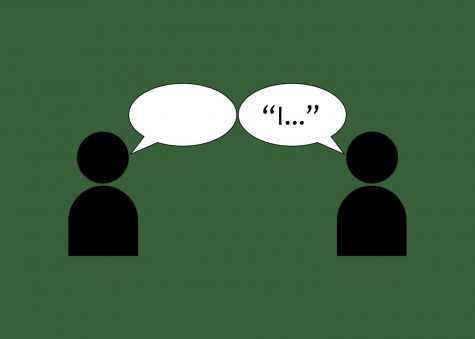Guide: How to have a conversation with someone you disagree with
Simple steps you can take to help engage in meaningful and respectful discussion
If you find yourself in a situation where you are speaking to someone who has different views on a certain subject, here is a guide for how to have the conversation.

1. Why are you having this conversation?
The first step in having a conversation with someone you disagree with is to ask yourself why you are having this conversation, said Robert Prichard, the Speech and Debate teacher. Is the purpose of this conversation to bring the other person down and ridicule them for their opinion or make fun of them for their beliefs? If these are some of the reasons you are wanting to have this conversation, you should probably not be engaging in it to begin with.
“The point of conversations should be to build understanding,” Prichard said.
If you are engaging in the conversation because you genuinely want to hear the other person’s perspective on the subject, then it is okay to continue with the conversation.

2. Willing Participants—Do both people want to have this conversation?
Having willing participants is another important part of having the conversation. If both parties are not willing to talk with each other then don’t talk about that subject, Natalie Elkin, the Peer Counseling teacher, mentioned. Move on to something else that will be less controversial.
If both people are willing to talk with each other, you also need to make sure that both people realize where the conversation could go and what questions may come up. If either person is nervous about any of those things, move on to something different.
“(When) entering into a conversation, (both people can’t) take things personally because they’re both allowed their idea, they’re not telling (the other person that they are) a bad person, they’re not telling (the other person they are) stupid, they’re not telling (the other person they are) wrong,” Elkin said. “(They) just have to be aware that (they’re) having an exchange of ideas.”

3. Ground Rules
In controversial conversations, it is good to set some rules and precautions before, just to make sure things don’t get out of hand.
Some ways you can do this are to specify some guidelines for the conversation. Talking about where it could lead, where either person is going to draw the line and change the subject or what topics are off limits are good ways to set guidelines, Sabrina Vella, the Wellness and Prevention Coordinator said.
“Do you want to be able to prove your point? Do you want to change their mind? Do you want to have them be on the listening end? Because if (everyone isn’t) on the same page as far as what (they) want to get out of (the) conversation, it will most likely end in disaster,” Vella said.
Another way to keep the conversation from turning into something more intense and less organized, is to set a timer for a certain amount of time. Each participant could get a specific amount of time to voice their opinions while the other person listens.
And, because you have set these guidelines, it will help to prevent you from getting too emotionally involved in the topic you are both speaking about.

4. Define Definitions
Defining definitions is also something that can prevent the conversation from getting heated and straying from its original direction.
When you define definitions both parties are coming to an agreement upon what a subject or word means to them, and when both people tell the other person their initial beliefs on a very broad subject and their personal definition of it, they may find that they already agree on many aspects of the subject.
“Sometimes it can be really helpful for you to find ways, and be really intentional on the places that (you) do agree. And that can be really helpful when you’re having those conversations with somebody you disagree with,” Vella said.
Come to an agreement on these things before engaging in the conversation so you are both on the same page of what you are both talking about. This way, there will not be two different things being discussed in one conversation that was supposed to be talking about the same thing.

5. Have Conversation
- Speaker’s Role:
As the speaker in a conversation it is your job to state your opinion on the subject you are speaking about without offending or ridiculing the other person and their beliefs. Using “I” statements instead of “you” statements are a good way to do this. For example you could say, “I feel that…” instead of, “you disagree with my feelings that…” These help the listener to feel like you are not attacking them for their beliefs, rather, simply stating what you believe, Elkin and Vella explained.
“Instead of the tear down, it is better to really present your case, present your facts (or) present your perspective,” Elkin said. “It is a much better approach than tearing down the opponents.”
- Listener’s Role:
As the listener in a conversation, you need to be conscious of your emotions as you hear the other person’s opinions. When you begin to feel your emotions heightening it is a good time to end the conversation, Elkin said. Your emotions can cloud your judgement which can play a large role in how you would approve the other person’s opinion when they are done speaking. If your heart rate gets to 100 beats per minute or more, the human body loses its ability to properly think clearly she explained. Other signs that can let you know you are getting emotional are:
- Crossed arms and/or legs
- Clenched fists
- Tight muscles
Being an active listener is also something that should be actively happening in the conversation. Gestures like head nods and intermittent words or sounds of understanding and comprehension are ways to let the speaker know you are listening to them and hearing what they are saying.
“Sometimes (people) go into conversations and they have what their responses are going to be, what their answers are (and) what their view point is that they want to come across, but if (you) come from a place of listening and curiosity and asking questions, those conversation can often look very different when you are having a disagreement,” Vella said.
Actively reflecting back points and concepts the speaker is making is a good way to be an active listener as well. If the speaker feels that you are not listening to them they will begin to lose sight of the end goal and start to feel that you are not making an effort to see their side of the conversation.

6. Respectfully Disagreeing with Someone
When you are disagreeing with someone’s point you can do it in a kind manner or in a disrespectful manner. When disagreeing, it is important to use “I” statements instead of “you” statements as well.
“It’s cliché now, but it is so true. Work with ‘I’ statements, not ‘you’ statements,” Elkin said.
There are also good and bad ways to begin sentences where you are disagreeing with the other person. Within Vella’s practice, she refers to a Discussion Sentence Starters sheet; with some good examples like:
- I don’t quite agree with your point about…
- My idea is slightly different. I think…
- I understand that… however…
- While it may be true that… I believe…

7. Seeking to Understand
Once you have heard both sides to the topic that you are discussing, it is important to go over the two sides together in the end, Elkin, Prichard and Vella all agree. If you are asked a question about what you said, answer honestly, but make sure you do not put the other person down. The point of the discussion is to hear a different angle on the topic and learn more about it.
“(It is also important to recognize) that understanding where someone is coming from is not the same thing as agreeing with them,” Elkin said.
It is okay to not come to an agreement in the end. People are entitled to have their own opinions and have their own ideas about certain topics.
“I don’t think people often change their minds because of conversations,” Prichard said. “I think the best you can hope for is you will make them think about something in a different way.”
Kaylee is a sophomore, and this is her first year on the Gazette.








